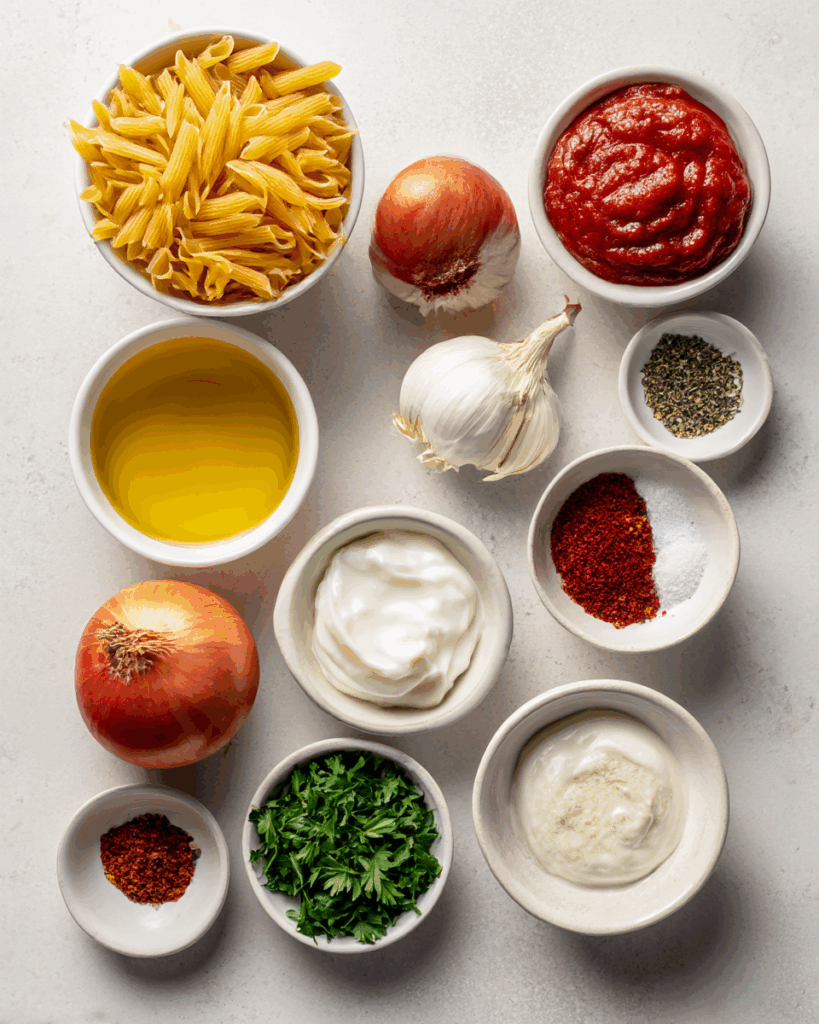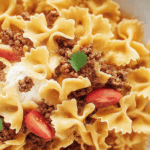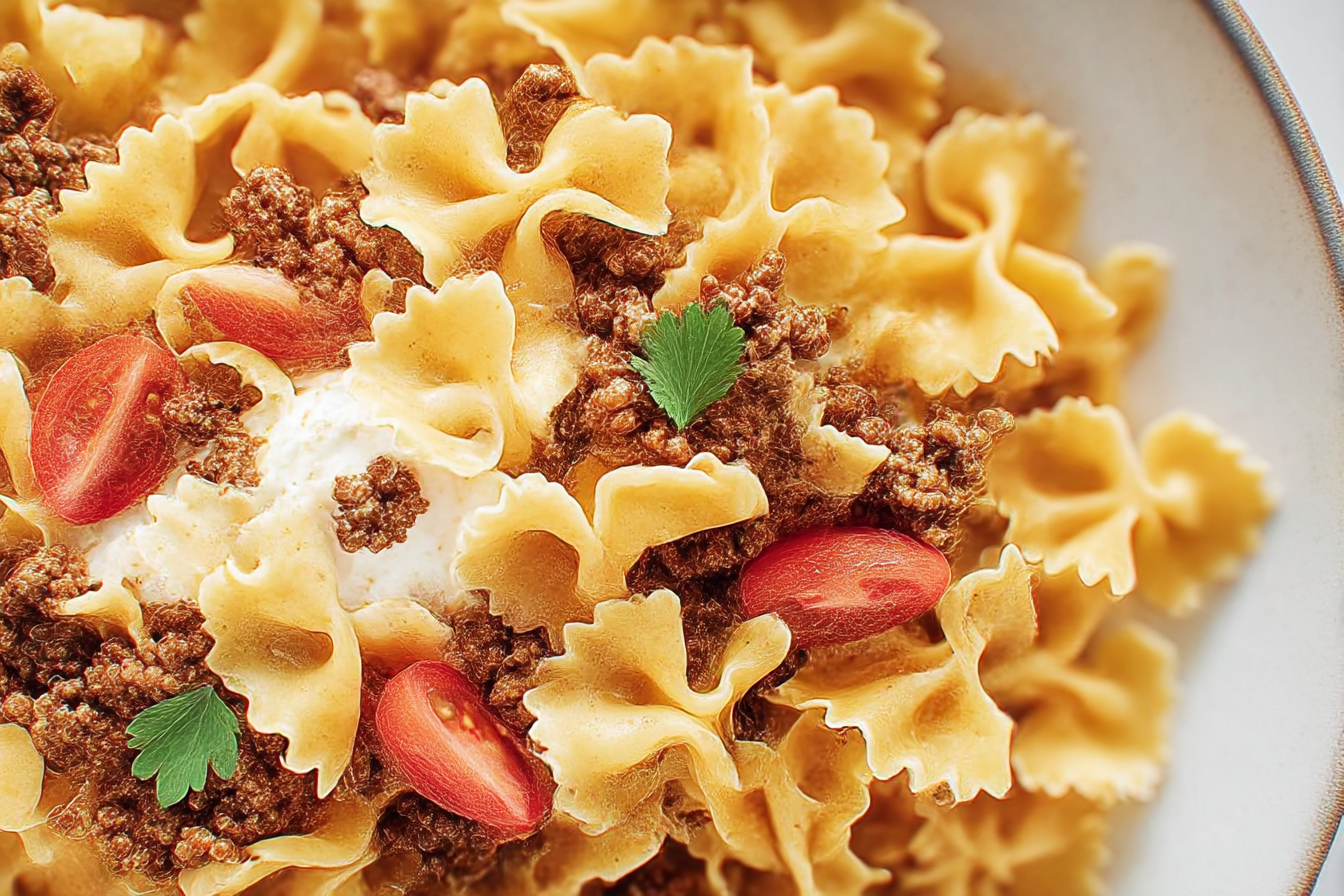If comfort had a flavor, it would taste like Turkish Pasta — tender noodles coated in garlicky yogurt, topped with a drizzle of warm butter infused with paprika, and finished with a sprinkle of herbs. It’s simple yet elegant, the kind of dish that soothes and delights all at once. Trust me, you’re going to love this.
Behind the Recipe
I first experienced Turkish Pasta, known locally as Yoğurtlu Makarna, in a small café in Istanbul overlooking the Bosphorus. The aroma of garlic butter wafting through the air was irresistible. What struck me most was its simplicity — no elaborate sauces or heavy cream, just the harmony of yogurt, garlic, and warm spices. It’s a dish that feels homemade, deeply comforting, and yet so full of character.
Recipe Origin or Trivia
Turkish Pasta, or Yoğurtlu Makarna, has its roots in the Ottoman kitchen, where yogurt was often paired with savory ingredients. It’s one of the simplest and most beloved comfort foods in Turkey, blending the creaminess of yogurt with the richness of butter and paprika. This dish shows the Turkish genius for combining humble ingredients into something extraordinary.
Why You’ll Love Turkish Pasta
From its creamy base to its golden, aromatic drizzle, this dish is irresistible.
Versatile: Works as a main course, side dish, or light dinner.
Budget-Friendly: Uses pantry staples like pasta, yogurt, and butter.
Quick and Easy: Ready in less than 25 minutes.
Customizable: Adjust the garlic, spices, or add protein like chicken or chickpeas.
Crowd-Pleasing: Comforting, familiar flavors everyone loves.
Make-Ahead Friendly: Yogurt sauce and butter drizzle can be prepped in advance.
Great for Leftovers: Tastes just as good chilled or gently reheated.
Chef’s Pro Tips for Perfect Results
The secret lies in balance — creamy yogurt, fragrant butter, and just the right amount of garlic.
- Use full-fat yogurt: It creates a richer, silkier sauce that won’t curdle.
- Don’t overheat the yogurt: Warm it gently with pasta to prevent separation.
- Add garlic gradually: Start with one clove and increase to taste.
- Use real butter: It gives a nutty, authentic flavor when melted with paprika.
- Serve immediately: This dish is best enjoyed fresh while the butter is warm and aromatic.
Kitchen Tools You’ll Need
Let’s make sure you have everything you need before diving in.
- Large Pot: For boiling pasta evenly.
- Strainer: To drain pasta perfectly without sticking.
- Mixing Bowl: For whisking the yogurt sauce.
- Small Saucepan: To melt butter and infuse it with paprika.
- Garlic Press or Grater: For finely minced garlic that blends smoothly.
Ingredients in Turkish Pasta
This recipe comes together with a handful of simple ingredients that harmonize beautifully.
- Pasta: 12 ounces (about 340 g), any shape like penne, fusilli, or spaghetti.
- Plain Greek Yogurt: 1 ½ cups, full-fat for the creamiest texture.
- Garlic Cloves: 2, finely minced or grated, for a savory kick.
- Butter: 3 tablespoons, melted to a rich, nutty finish.
- Olive Oil: 1 tablespoon, to help the butter infuse smoothly.
- Paprika: 1 teaspoon, for a warm, smoky aroma.
- Salt: 1 teaspoon, to season the pasta and yogurt sauce.
- Black Pepper: ½ teaspoon, freshly ground for depth.
- Dried Mint or Dill: ½ teaspoon, for garnish and freshness.
- Lemon Zest (optional): A pinch, for brightness and balance.
Ingredient Substitutions
No need to stress — here’s how to adapt with what you have.
Greek Yogurt: Substitute with strained plain yogurt or labneh.
Butter: Use ghee or plant-based butter for a dairy-free version.
Paprika: Try Aleppo pepper for a touch of heat.
Dried Mint: Fresh mint or parsley works wonderfully too.
Pasta: Whole wheat or gluten-free pasta also fits perfectly.
Ingredient Spotlight
Yogurt: The creamy heart of Turkish cuisine — tangy, cooling, and rich. It balances the butter’s warmth beautifully.
Paprika Butter: A classic Turkish finishing touch that adds color, aroma, and a subtle smokiness.

Instructions for Making Turkish Pasta
Now let’s bring this comforting classic to life step by step.
- Preheat Your Equipment: Set a large pot of salted water to boil.
- Combine Ingredients: Cook pasta according to package directions until al dente, then drain and set aside.
- Prepare Your Cooking Vessel: In a small saucepan, melt butter with olive oil over low heat. Add paprika and stir for 30 seconds until fragrant. Remove from heat.
- Assemble the Dish: In a mixing bowl, whisk yogurt with minced garlic, salt, and pepper. Add the warm pasta gradually, stirring to coat evenly.
- Cook to Perfection: If needed, add a tablespoon of warm pasta water to loosen the sauce. Do not reheat directly or the yogurt may curdle.
- Finishing Touches: Drizzle the warm paprika butter over the top. Sprinkle with dried mint or dill.
- Serve and Enjoy: Serve immediately, optionally topped with a touch of lemon zest or extra herbs.
Texture & Flavor Secrets
This dish thrives on contrast — silky yogurt clinging to tender pasta, cut by the smoky heat of paprika butter and the brightness of herbs. The creamy tang of yogurt is comfort in every bite, while the butter adds a golden, velvety depth that lingers.
Cooking Tips & Tricks
- Reserve a bit of pasta water before draining to adjust sauce texture.
- Mix yogurt and pasta while the pasta is warm, not hot.
- For an extra kick, add a sprinkle of red chili flakes to the butter.
What to Avoid
- Avoid using low-fat yogurt — it tends to curdle easily.
- Don’t pour hot butter directly into the yogurt bowl; drizzle it gently to preserve texture.
- Avoid letting pasta cool too much before mixing; it won’t absorb the flavors well.
Nutrition Facts
Servings: 4
Calories per serving: 420
Note: These are approximate values.
Preparation Time
Prep Time: 5 minutes
Cook Time: 15 minutes
Total Time: 20 minutes
Make-Ahead and Storage Tips
You can prepare the yogurt sauce ahead and store it in the fridge for up to 2 days. The pasta can also be cooked in advance and tossed with olive oil to prevent sticking. Combine just before serving and warm gently. Leftovers can be stored in an airtight container for up to 3 days and served cold or reheated gently.
How to Serve Turkish Pasta
Serve this dish warm or at room temperature with a side of grilled vegetables or a crisp cucumber salad. It also pairs beautifully with Turkish lentil soup or flatbread for a full Mediterranean meal.
Creative Leftover Transformations
- Turn leftovers into a cold pasta salad with fresh herbs and lemon.
- Add chickpeas or shredded chicken for a protein-packed lunch.
- Bake it briefly with extra cheese for a new twist on comfort food.
Additional Tips
Always use room-temperature yogurt to prevent curdling. A small touch of lemon zest can lift the flavors beautifully. If serving to guests, drizzle extra paprika butter tableside for a stunning presentation.
Make It a Showstopper
Serve in a shallow white bowl to showcase the golden butter swirl and vibrant herbs. A few extra mint leaves and a dusting of paprika make it visually irresistible.
Variations to Try
- Spicy Version: Add Aleppo pepper or crushed red chili.
- Vegetable Boost: Toss in roasted eggplant or zucchini.
- Herby Freshness: Use dill, parsley, or cilantro for variety.
- Garlic Lovers: Double the garlic for extra flavor.
- Protein Twist: Add sautéed chicken strips or chickpeas.
FAQ’s
Q1: Can I use low-fat yogurt?
You can, but it may separate. Full-fat works best for creaminess.
Q2: Can I use spaghetti instead of penne?
Yes, any pasta shape works well in this recipe.
Q3: How do I keep the yogurt from curdling?
Combine it with warm (not hot) pasta and mix gently.
Q4: Is this dish served hot or cold?
Traditionally warm, but it’s delicious cold as well.
Q5: Can I make this vegan?
Yes, use plant-based yogurt and butter alternatives.
Q6: What’s the best paprika to use?
Sweet paprika or Aleppo pepper for a touch of heat.
Q7: Can I add vegetables?
Absolutely — spinach, peas, or roasted peppers pair wonderfully.
Q8: Is it good for meal prep?
Yes, store components separately and combine before serving.
Q9: Can I make it spicier?
Add chili flakes or use hot paprika.
Q10: How long does it last in the fridge?
Up to 3 days in an airtight container.
Conclusion
Turkish Pasta is the definition of elegant simplicity — creamy, aromatic, and utterly comforting. With just a few pantry ingredients, you can create a dish that feels both exotic and familiar. Let me tell you, it’s worth every forkful.
Print
Turkish Pasta
Description
A creamy, comforting Turkish Pasta made with garlicky yogurt sauce, warm paprika butter, and fresh herbs — a simple yet rich Mediterranean dish ready in 20 minutes.
Ingredients
- 12 ounces (340 g) pasta (penne, fusilli, or spaghetti)
- 1 1/2 cups plain full-fat Greek yogurt
- 2 garlic cloves, finely minced or grated
- 3 tablespoons butter
- 1 tablespoon olive oil
- 1 teaspoon paprika
- 1 teaspoon salt
- 1/2 teaspoon black pepper
- 1/2 teaspoon dried mint or dill
- Pinch of lemon zest (optional)
Instructions
- Bring a large pot of salted water to a boil and cook pasta according to package directions until al dente.
- Drain the pasta, reserving about 1/4 cup of pasta water.
- In a small saucepan, melt the butter with olive oil over low heat, then stir in paprika and cook for 30 seconds until fragrant. Remove from heat.
- In a large mixing bowl, whisk together yogurt, garlic, salt, and black pepper.
- Add the warm pasta gradually into the yogurt mixture, tossing gently to coat evenly. Add a splash of reserved pasta water if needed to loosen the sauce.
- Drizzle the paprika butter over the pasta and sprinkle with dried mint or dill.
- Serve immediately, topped with a touch of lemon zest or extra herbs if desired.
Notes
- Note: Use full-fat yogurt to ensure the sauce stays creamy and doesn’t curdle.
- Warm the pasta slightly before mixing — hot pasta can split the yogurt.
- For extra spice, add Aleppo pepper or chili flakes to the butter.

